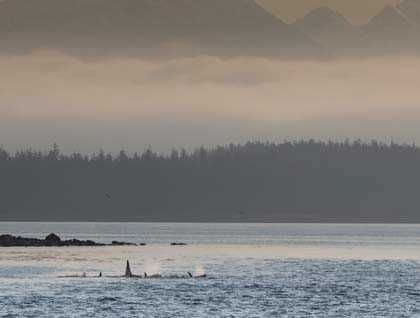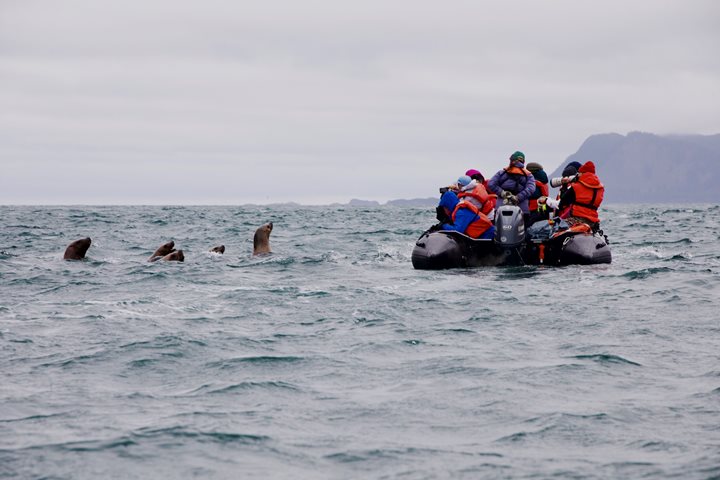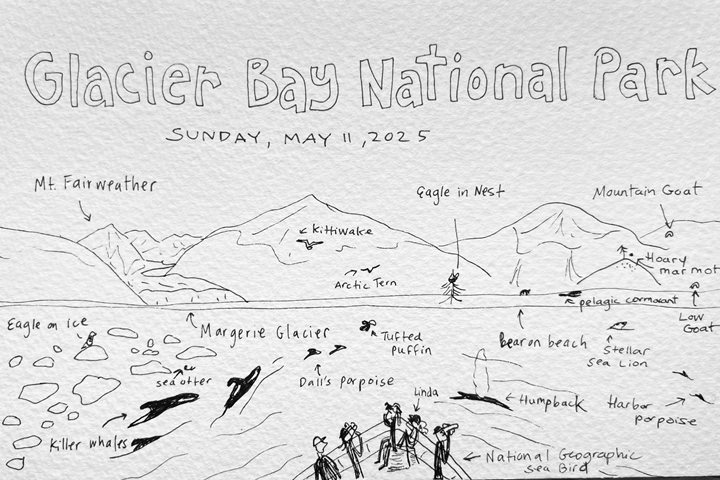Glacier Bay is an iconic destination, a keystone of Alaska’s natural history. Pristine, wild, and unspoiled are just a few words used to describe this giant basin. Carved thousands of years ago by ice thousands of feet thick, glaciers moved like slow motion juggernauts, pulverizing everything in their path, leaving the earth’s crust deeply cleaved. Once the ice receded, the ocean returned and filled the valleys with water, creating a bay that appears designed by nature to explore by small ship.
Guests aboard National Geographic Sea Bird enjoyed a quiet night as the ship was tied up at the National Park Service docks in Bartlett Cove. Before 0600, our Park Rangers and guides were aboard, and the order was given to cast off. It’s 52 nautical miles from the entrance of the bay to the Margerie Glacier at the north end, so an early start was in order to make the most of our daylight hours.
With this trip already filled with so many highlights, expectations were high for sightings of species we’ve yet to spot. Orca of course topped that list, and before breakfast could even be served, the call of “ORCA!” announced that killer whales were just off our starboard. The daily questions of, “Will we see any orca?” have been answered in the affirmative. A small pod, perhaps a dozen strong, swim slowly south hugging the mainland beach, their puffy spouts glistening in the morning sunlight. At least two bulls were escorting a pod that included a few mother and calf pairs. One of the mothers surprised us when she surfaced just in front of our bow with her small calf following close alongside. It was, for many of us, as close as we have ever been to an orca.
It was finally time to head north up the bay, and leave the orca family to their breakfast. The next stop was at a large nude dome of rock known as Gloomy Knob, poking about 1300’ above the water. The local rangers say that it got its name from the persistent shroud of fog or mist that hovers over the knob, but today clear blue skies prevailed.
Photo instructor and naturalist Michael Nolan was searching the knob for wildlife, hoping perhaps to spy a mountain goat, when he saw a beautiful, burley brown bear about halfway up the rocks. What a delight for all to gather on the bow, on a warm morning and watch such a magnificent, healthy bear forage for food, occasionally glancing in our direction with a suspicious look. This early in the spring, the salmon have yet to begin running in the streams, so any meal this bear finds is a meal worth protecting.
Soon the ship moved on, as we had many miles to cover today. During lunch, a very distant wolf was briefly seen on the shore, and the waters teamed with sea otter, gulls, loons, murrelets, terns, and other seabirds. Dall’s porpoise and humpback whales also made a few splashes near the bow.
The afternoon was primarily ship cruising, with a long stop at Margerie Glacier, which meets the water at the north end of Tar Inlet. Black-legged kittiwakes and harbor seals entertained us while we waited for the cracks and booms to produce a large calving that never developed.
As we are now in the final days of this adventure, we were most thankful to see two of Alaska’s signature species, the brown bear and the orca. Perhaps tomorrow, our final full day, we might see a moose?







